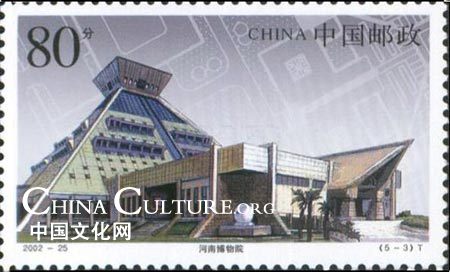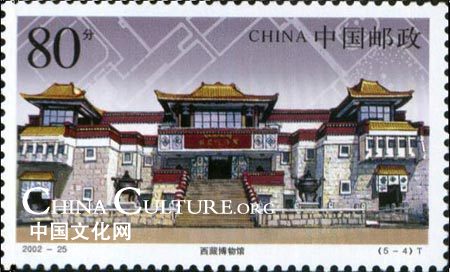Museums in the stamps
 |
|
|
Modern technological means have been adopted, such as audio tour, magnified video-tape playing, computer consultation and visitors' interactive facilities, so as to meet the needs of visitors for knowledge and appreciation of cultural relics and for entertainment.
As a modern museum, Henan Museum is equipped with advanced security system, automatic building management system, audio-visual education system, service information computer network system, cultural relics preservation, protection and research system and other high technology equipment.
Henan Museum is a modern base for cultural relic’s collection, exhibition, preservation, research, dissemination and education.
The Stamp of Tibet Museum with the postage of 80 cents
The Tibet Museum is located in the southeast corner of Norbu Lingka, Lhasa city. It covers an area of 23,508 square meters (5.8 acres) including the exhibition area of 10,451 square meters (2.6 acres). The museum is equipped with modern facilities to ensure quality service for visitors and safety and efficient administration of the museum itself. Here exhibits are introduced in Japanese, English, Tibetan, and Chinese, in order to accommodate visitors from all over the world.
 |
|
|
The construction project of the Tibet Museum was listed as one of the sixty-two "Aid-Tibet Projects" in July 1994.The museum opened in October 1999 to coincide with the 50th anniversary of the Founding of the People's Republic of China and the 40th anniversary of Tibet's Democratic Reform. The former Chinese chairman Jiang Zemin inscribed the named for the Museum. The museum building is a pioneering institution in the history of Tibet. Designed by a Han Chinese architect from Sichuan province, the complex is a wonderful combination of Chinese and Tibetan architectural styles.
The Stamp of Tianjin Natural History Museum with the postage of 80 cents
The Tianjin Natural History Museum, located at the west end of the Machang Road, was set up in 1914 by a French missionary and opened in 1927, with the previous name as Beijiang Museum. It got the present name in 1957.
 |
|
|
The museum is specialized in collections of paleontology and paleo-anthropology fossils. Specimens total 380,000, and the key collections show the paleontology group in the late period of Chinese Cenozoic Era, including fossils of ancient mammals excavated from the Yushe Basin of Shanxi Province, the Qingyang Basin of Gansu Province, the Yang Yuanni Basin of Hebei Province and the Inner Mongolia -- the abundance of paleontology groups of the four places are rare worldwide, which are important references for researches on the evolvement of amniotes.
The museum features four basic displays of Animal, Paleontology, Plants and Paleo-anthropology fossils, containing ancient reptiles and mammals, animal ecology, insects and aquatic organisms.
















